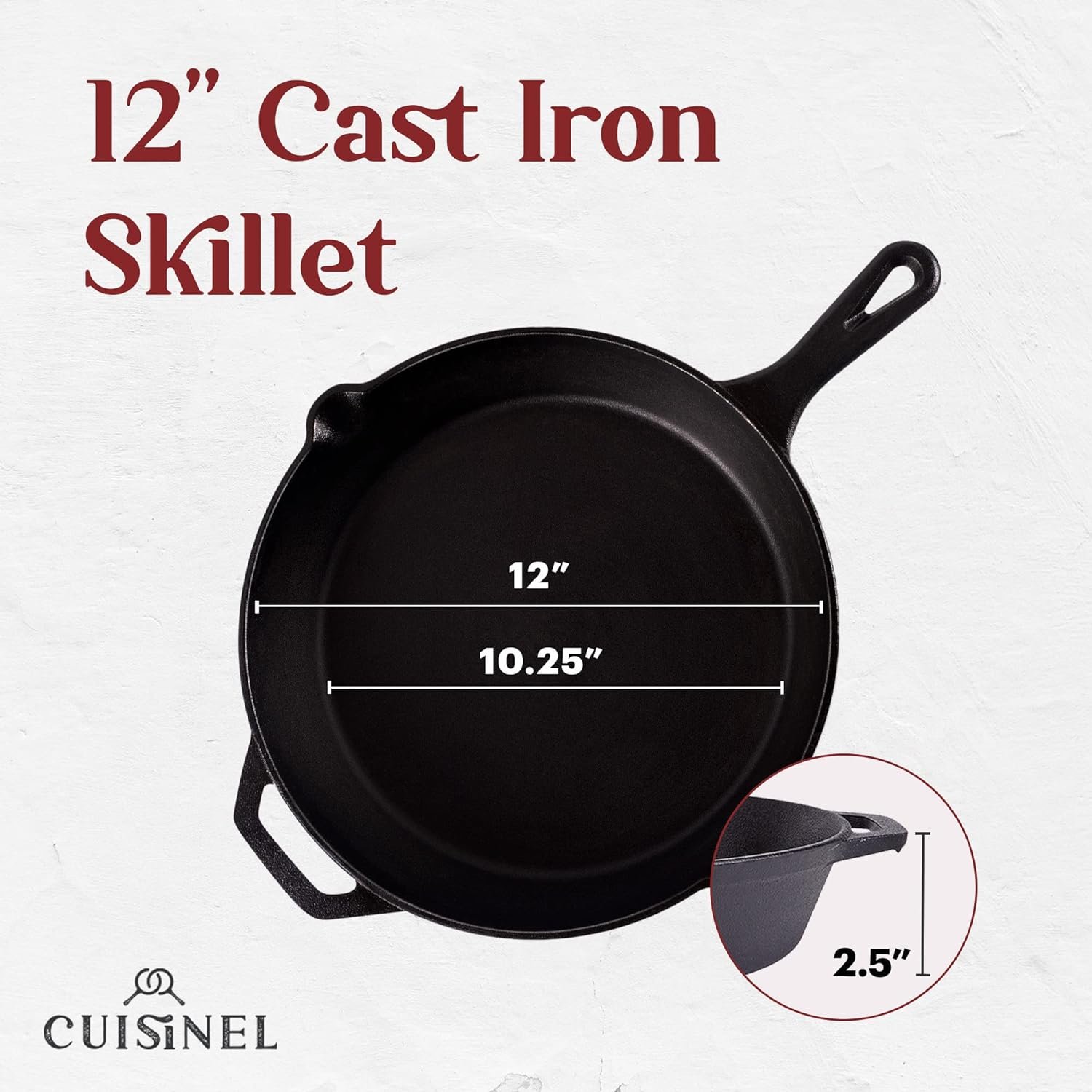
Cooking with cast iron can elevate your culinary skills and make your meals taste amazing. This guide will help you understand how to use cast iron cookware like a pro while steering clear of common pitfalls. Whether you’re a beginner or looking to refine your technique, these tips will enhance your cooking experience and keep your cast iron in top shape.
Key Takeaways
- Always season your cast iron skillet properly for a nonstick surface.
- Avoid cooking acidic foods to prevent a metallic taste and damage to the seasoning.
- Preheat your skillet to ensure even cooking and prevent sticking.
- Use the right utensils, like metal spatulas, to maintain your skillet’s surface.
- Regularly clean and dry your skillet to avoid rust and keep it in good condition.
Understanding the Basics of Cast Iron Cookware
What Makes Cast Iron Unique
Cast iron cookware is known for its excellent heat retention and even cooking. Unlike other materials, cast iron can withstand high temperatures, making it perfect for searing and frying. Its ability to hold heat means that food cooks evenly, which is why many chefs prefer it.
The Importance of Seasoning
Seasoning is crucial for cast iron. It creates a natural non-stick surface and protects the pan from rust. Properly seasoned cast iron can last a lifetime, and many families pass down their skillets through generations. A well-seasoned skillet enhances the flavor of your food.
Different Types of Cast Iron Cookware
There are several types of cast iron cookware:
- Skillets: Great for frying and sautéing.
- Dutch Ovens: Perfect for slow cooking and baking.
- Griddles: Ideal for pancakes and sandwiches.
| Type | Best For |
|---|---|
| Skillets | Frying, Searing |
| Dutch Ovens | Stews, Baking |
| Griddles | Breakfast, Sandwiches |
Cast iron is a versatile tool in the kitchen. With the right care, it can be your best cooking companion for years to come.
In summary, understanding the basics of cast iron cookware is essential for anyone looking to cook like a pro. Whether you’re a beginner or an experienced cook, knowing how to use and care for your cast iron will elevate your culinary skills. Remember, this quick-start guide covers everything from the benefits of cast iron to proper care techniques.
Seasoning Your Cast Iron Skillet Properly
What is Seasoning?
Seasoning is the process of creating a non-stick surface on your cast iron skillet. This is essential for effective cooking. It involves applying oil and heating the skillet to form a protective layer.
Steps to Season Your Skillet
- Apply a thin coat of vegetable oil all over the skillet, including the handle.
- Place the skillet upside down in an oven preheated to 350°F for one hour.
- Turn off the oven and let the skillet cool inside.
| Step | Action | Temperature |
|---|---|---|
| 1 | Apply oil | Room Temp |
| 2 | Heat in oven | 350°F |
| 3 | Cool down | Room Temp |
Common Seasoning Mistakes to Avoid
- Not using enough oil: A thin layer is key; too much can lead to a sticky surface.
- Skipping the cooling step: Letting it cool in the oven helps the seasoning set properly.
- Ignoring dull spots: Re-season whenever you notice dull areas to maintain the non-stick surface.
Remember, seasoning is not a one-time task. Regularly re-season your skillet to keep it in top shape!
Cooking Techniques for Cast Iron
Preheating Your Skillet
Before you start cooking, it’s essential to preheat your skillet. This helps to create a non-stick surface and ensures even cooking. Here’s how to do it:
- Place your skillet on the stove over medium heat.
- Allow it to heat for about 5-10 minutes.
- Test the heat by sprinkling a few drops of water; they should sizzle and evaporate quickly.
Cooking at the Right Temperature
Using the right temperature is crucial for successful cast iron cooking. Here are some tips:
- Start with medium heat for most recipes.
- Adjust the heat as needed; cast iron retains heat well.
- For searing, use high heat, but be careful not to overheat and damage the seasoning.
Using the Right Utensils
To protect your skillet, always use utensils that won’t scratch the surface. Here are some recommended options:
- Wooden spoons
- Silicone spatulas
- Plastic utensils
Remember: Using metal utensils can damage the seasoning and lead to rust.
By following these techniques, you can enjoy cooking with your cast iron skillet while avoiding common pitfalls. Mastering these skills will elevate your cooking experience!
Foods to Avoid Cooking in Cast Iron
Cooking with cast iron is a great way to enhance your meals, but there are certain foods you should steer clear of. Here’s what to keep in mind:
Acidic Foods
Avoid cooking acidic foods in cast iron. Ingredients like tomatoes, vinegar, and lemon juice can react with the metal. This can lead to a metallic taste in your food and damage the skillet’s seasoning. If you’re making a tomato sauce, consider using a different pot instead.
Delicate Foods
When it comes to cooking delicate items, cast iron might not be your best friend. Foods like flaky fish can easily fall apart in a cast iron skillet. Instead, opt for a nonstick or stainless-steel pan for these types of dishes.
Sticky Foods
If your skillet is new or not well-seasoned, sticky foods can be a nightmare. Items like pancakes or scrambled eggs may stick to the surface, making cleanup a hassle. Here are some foods to avoid until your skillet is well-seasoned:
- Pancakes
- French omelets
- Fried rice
Remember, using cast iron can be rewarding, but knowing what not to cook is just as important!
Cleaning and Maintenance Tips
How to Clean Your Skillet
To keep your cast iron skillet in great shape, clean it while it’s still warm. Here’s how:
- Rinse the skillet with warm water.
- Sprinkle in some baking soda or coarse salt.
- Use a soft sponge to scrub away any leftover food.
Preventing Rust
To avoid rust, never soak your skillet in water. Instead, dry it thoroughly right after washing. If you notice any rust spots, scrub them off with a bit of oil and salt, then re-season your skillet.
Storing Your Cast Iron Properly
When storing your cast iron, make sure it’s completely dry. You can place a paper towel inside to absorb any moisture. Avoid stacking other cookware on top to prevent scratches.
Remember, proper care will make your cast iron skillet last a lifetime!
Common Mistakes and How to Fix Them
Not Preheating the Skillet
One of the biggest mistakes is not preheating your skillet. Preheating is essential for even cooking. Here’s how to do it:
- Place your skillet on the stove.
- Turn the heat to medium.
- Wait for about 5-10 minutes before adding food.
Using Too Much Heat
Many people think more heat equals better cooking, but that’s not true with cast iron. Using too much heat can lead to burnt food and a damaged skillet. Instead, start with a lower heat setting and adjust as needed. Remember, cast iron retains heat well, so you often don’t need high temperatures.
Improper Cleaning Techniques
Cleaning your cast iron skillet is crucial for its longevity. Avoid using soap or putting it in the dishwasher. Instead, follow these steps:
- Rinse with hot water immediately after use.
- Use a stiff brush or sponge to remove food particles.
- Dry it thoroughly to prevent rust.
Remember, taking care of your cast iron skillet will ensure it lasts for generations. Treat it well, and it will reward you with delicious meals!
Enhancing Your Cast Iron Cooking Skills
Experimenting with Recipes
To truly master your cast iron skillet, try out different recipes. Here are some ideas to get you started:
- Searing meats: Perfect for steaks and chicken.
- Baking: Use it for cornbread or even pizza.
- Stir-frying: Great for veggies and quick meals.
Using Cast Iron for Baking
Cast iron isn’t just for stovetop cooking. It can also be used for baking! Here’s how:
- Preheat your skillet in the oven.
- Pour in your batter or dough.
- Bake until golden brown.
Tip: The heat retention of cast iron gives baked goods a nice crust.
Tips for Long-Term Care
To keep your cast iron skillet in top shape, follow these care tips:
- Regularly season your skillet to maintain its non-stick surface.
- Avoid cooking acidic foods that can break down the seasoning.
- Store it dry to prevent rust.
Remember, a well-cared-for cast iron skillet can last a lifetime! Treat it right, and it will reward you with delicious meals.
Final Thoughts on Cooking with Cast Iron
Cooking with cast iron can be a rewarding experience if you follow the right steps. Remember, your skillet is a tough tool that can last a lifetime with proper care. Avoid common mistakes like cooking acidic foods or storing leftovers in the pan. Instead, focus on seasoning it well and using it often. With a little practice, you’ll be able to whip up delicious meals while enjoying the benefits of this versatile cookware. So, get cooking and make the most of your cast iron skillet!
Frequently Asked Questions
What is cast iron cookware?
Cast iron cookware is a type of kitchen tool made from iron that is known for its ability to retain heat and provide even cooking. It’s great for frying, baking, and more.
How do I season my cast iron skillet?
To season your skillet, clean it well, apply a thin layer of oil, and bake it upside down in the oven at a high temperature for about an hour. This creates a nonstick surface.
Can I cook acidic foods in cast iron?
It’s best to avoid cooking very acidic foods, like tomatoes, for long periods in cast iron, as they can affect the seasoning and flavor.
How do I clean my cast iron skillet?
To clean your skillet, rinse it with hot water and scrub it gently with a brush or sponge. Avoid soap, as it can strip the seasoning.
How can I prevent rust on my cast iron?
Make sure to dry your skillet completely after washing it and apply a light coat of oil before storing it to prevent rust.
What are some common mistakes when using cast iron?
Common mistakes include not preheating the skillet, using too much heat, and not re-seasoning it regularly.







